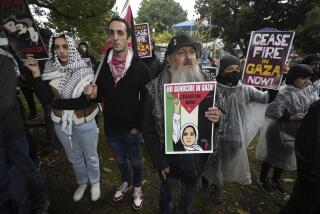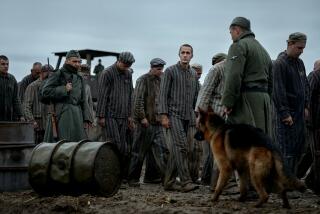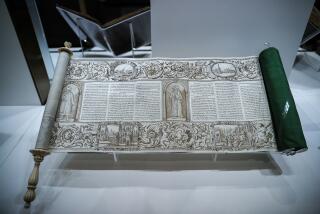Repaying a Debt Never Forgotten
Smoke was thick and mortar fire shook the ground when Cpl. Sylvan Katz first caught a glimpse of the Igorot people. It was January 1945, and Katzâs U.S. Army 32nd Red Arrow Division was locked in combat with Japanese troops on the rugged Villa Verde trail in northern Luzon, the Philippines. When Katz first landed in Luzon, an old Army sergeant told the troops they would meet pagan headhunters if they were sent to the mountains.
What Katz saw through the tumult was a contingent of small-statured men, women and boys carrying 5-gallon cans of water, heavy boxes of ammunition, rations and sacks of letters from home. âWe were amazed to see this group of cargadores coming up the front lines where they were exposed to enemy machine gun fire,â recalls Katz, 74, now a retired administrative judge living in Santa Monica. He believes that the Igorotsâ selfless performance was crucial to the success of the campaign against the Japanese.
It was the Igorots who trekked in supplies and ferried out wounded and dead U.S. soldiers from steep areas inaccessible to Army vehicles. Igorot scouts struck at enemy supply dumps and boldly rode on the fronts of tanks attacking the Japanese. Their bravery was legendary. Gen. Douglas MacArthur praised them, saying: âFor sheer, breathtaking and heart-stopping desperation, I have never known the equal of those Igorots.â
Unlike many appreciative soldiers, though, Katz has tried to repay a debt of gratitude to the Igorots. In 1975, on his first return visit to the Philippines, Katz embarked on what has become a lifelong project.
Strolling through a cultural center in Manila, he met two young women--Bugan Annayao and her cousin Fely Ballogan--demonstrating traditional crafts. âHe was very excited to learn we were from the mountain provinces,â says Annayao, reached by phone in the Philippines. âHe remembered our people well from his experiences in the war.â
Learning that the cousins lacked the means to pursue college educations, Katz offered financial assistance. Since that first meeting, Katz has helped 15 young Igorots of the Ifugao tribe to obtain their college educations in the Philippines. They are now teachers, nurses, experts in modern agriculture. Most have chosen to raise their families and practice their skills in their native mountain villages.
Katzâs unit spent eight months in the mountains with Igorots of the Ifugao and Benguet tribes. The term âIgorot,â he learned, refers collectively to the seven ethnic minorities of the mountain provinces. Historically, the Igorot tribes were unbowed by Spanish or American colonization. (Because of their remote location and reputation as headhunters, no explorers pressed the issue.)
*
Katzâs relationship with the Igorot people is evident in his daily life. In his condo in Santa Monica, wooden carvings of animals and rice deities vie for space with photos of grandchildren. His study is lined with boxes bulging with correspondence from his scholars. Katz, who still travels to Asia yearly, is never too busy to mentor a faraway student, to offer congratulations on a successful exam, to inquire about a parentâs health, to comment on a proposed course of study. At his retirement party in 1990, the indomitable silver-haired judge joined in ritual tribal dances with members of Los Angelesâ Igorot community. He was the only male dancer wearing a business suit instead of a G-string.
*
To be eligible for Katzâs college scholarship, a young Igorot had only to demonstrate financial need and a willingness to learn. At the outset, however, there was one other requirement Katz levied on his scholars: that they seek out their grandparents or elders in their villages to ask them about their memories of life during World War II, and then write an essay about what they learned. Katz believed this oral transmission of history would help to keep alive the memory of Luzon under Japanese occupation: the suffering endured and the bravery ventured.
Though he has since dropped the essay requirement, it was one of the ways that he dealt with his own dark memories of the war (during four months on the Villa Verde Trail, more than 800 American soldiers of the Red Arrow Division lost their lives). In his hallway is a framed Japanese flag, a good luck banner, which once belonged to a Japanese soldier.
âI donât want to talk about the flag,â he says somberly, but volunteers that he knows âit belonged to a young man who went to preparatory school outside Tokyo.â
In their essays, the scholars recounted what they learned from their grandparents: stories of physical cruelty and the deprivations of wartime. âPeople caught by the Japanese were forced to pump water from the well for their bath and consumption,â wrote Flora Leprozo. âAny animals stray or not were taken and butchered by them.â
Another scholar wrote, âIf the civilians were found by the Japanese favoring the guerrillas, they were arrested to be tortured and killed. Such was our life and suffering during the Japanese occupation.â
*
Because of Katzâs request, Annayao recalled, she asked her grandmother about her experiences during the war. What she learned surprised her. âThere are many Japanese in the Philippines now,â she says thoughtfully, âand for the most part we are friendly. But sometimes I remember and I feel angry.â
She mentions a story recently in the news, about a Filipina named Maria Rosa Henson who, at 15, was forced to serve as a âcomfort womanâ for the Japanese troops. Hensonâs book âComfort Woman: Slave of Destinyâ (Philippine Center for Investigative Journalism) was recently published both in the Philippines and Japan, where it caused a stir. Henson told reporters she issued her story specifically to humiliate the Japanese. âIt is true: I am an avenger of the dead,â she said.
On the other hand, Annayao also understands the statement made by the survivor of another war trauma: Phan Thi Kim Phuc. Phuc became a horrific image of the Vietnam War when, as a child of 8, she was photographed running naked down a road after a U.S. napalm attack on her South Vietnamese village. At Arlington National Cemetery last year, Phuc said she could forgive the U.S. pilot who dropped the bombs on her village. âWe cannot change history, but we should try to do good things for the present and for the future to promote peace.â
âThis statement explains what I feel about Sylvan,â Annayao says. âSylvan has chosen to make something good come out of his difficult experience in the war. He has had the heart to help me and to help my people.â
More to Read
Sign up for Essential California
The most important California stories and recommendations in your inbox every morning.
You may occasionally receive promotional content from the Los Angeles Times.










